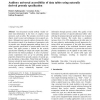Free Online Productivity Tools
i2Speak
i2Symbol
i2OCR
iTex2Img
iWeb2Print
iWeb2Shot
i2Type
iPdf2Split
iPdf2Merge
i2Bopomofo
i2Arabic
i2Style
i2Image
i2PDF
iLatex2Rtf
Sci2ools
UAIS
2010
2010
Auditory universal accessibility of data tables using naturally derived prosody specification
Abstract Text documents usually embody visually oriented meta-information in the form of complex visual structures, such as tables. The semantics involved in such objects result in poor and ambiguous text-to-speech synthesis. Although most speech synthesis frameworks allow the consistent control of an abundance of parameters, such as prosodic cues, through appropriate markup, there is no actual prosodic specification to speech-enable visual elements. This paper presents a method for the acoustic specification modelling of simple and complex data tables, derived from the human paradigm. A series of psychoacoustic experiments were set up for providing speech properties obtained from prosodic analysis of natural spoken descriptions of data tables. Thirty blind and 30 sighted listeners selected the most prominent natural rendition. The derived prosodic phrase accent and pause break placement vectors were modelled using the ToBI semiotic system to successfully convey semantically important ...
| Added | 23 May 2011 |
| Updated | 23 May 2011 |
| Type | Journal |
| Year | 2010 |
| Where | UAIS |
| Authors | Dimitris Spiliotopoulos, Gerasimos Xydas, Georgios Kouroupetroglou, Vassilis Argyropoulos, Kalliopi Ikospentaki |
Comments (0)

